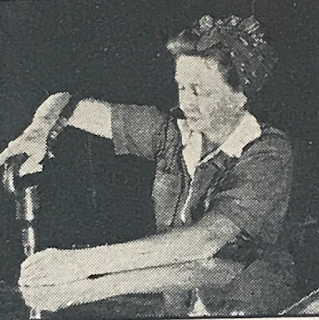The Bruton Sisters: Wartime Heroines

Esther Bruton working as a riveter during World War II
The Consolidated News [newsletter for the Convair Company], San Diego, ca. 1944, p. 6.
 |
During World War I, Helen Bruton enlisted in the Naval Reserve and went to Washington D.C. to serve as a “yeomanette.” Women were allowed to join the Navy for the first time in 1917, and many worked as radio operators, stenographers, nurses, messengers, and chauffeurs. Helen worked as a steno-secretary for the Bureau of Yards and Docks from October 1918 through June 1919.
Margaret Bruton volunteered at the Letterman Hospital on the Presidio Army Base in San Francisco. During World War I, the Letterman Hospital cared for more than 18,000 soldiers who were seriously wounded or had psychiatric problems. Margaret worked as a “reconstruction aid," later known as occupational therapists. During the World War I, reconstruction aids were selected because of their “extensive art training” and were expected “to teach crafts on the wards to patients who had impaired motor function or who were neurotic or mentally disoriented.”1 Margaret would have been a perfect candidate to work in the field of occupational therapy; she used her love of art to serve her country by assisting injured and disabled soldiers during a time of great need.
 |
| Courtesy National Library of Medicine Public domain, ca. 1919 |
Moving ahead to World War II, Margaret and Helen -- like many women -- took over jobs traditionally performed by men. Both were employed as draughtsmen, putting their artistic talent to work as they labored over technical plans and drawings. Margaret was employed at the Alameda shipyard and Helen worked at the nearby Naval Air Station. Helen also participated in San Francisco’s “Arts and Skills” unit of the American Red Cross and volunteered one afternoon a week, demonstrating and teaching art projects to wounded soldiers. As “master craftsman” for the medium of mosaic, she supervised four to six other artists in the program.2
 |
| San Francisco Examiner, 15 Aug. 1943, p. 5 |
Esther spent part of World War II living in San Diego, where her husband had been hired by the engineering department of Convair, an aircraft manufacturing company. Esther did her part for the war effort by working as a riveter at the Convair factory. With her unflappable attitude and endless energy, Esther threw herself into her new occupation: “[T]here’s a certain amount of craftsmanship involved in this work,” she said in an interview in the Convair newsletter. “You must see that the rivet is flush with the skin, not just above or below. I like riveting tremendously because I like working with my hands and with actual materials.”3 A photograph accompanying the article shows Esther looking much like Rosie the Riveter, dressed in coveralls with a rivet gun in her hand and a bandana wrapped around her head.
1 Myra L. McDaniel, “Occupational Therapists Before World War II (1917-40),” United States Army Medical Department, Office of Medical History. https://history.amedd.army.mil/corps/medical_spec/chapteriv.html
2 San Francisco Examiner, 15 Aug. 1943, p. 2.
3 The Consolidated News [newsletter for the Convair Company], San Diego, ca. 1944, p. 6.


Comments
Post a Comment